北师版(2019)必修第三册Unit 7 Art Lesson 3 A Musical Genius 课件(共30张PPT)
文档属性
| 名称 | 北师版(2019)必修第三册Unit 7 Art Lesson 3 A Musical Genius 课件(共30张PPT) | 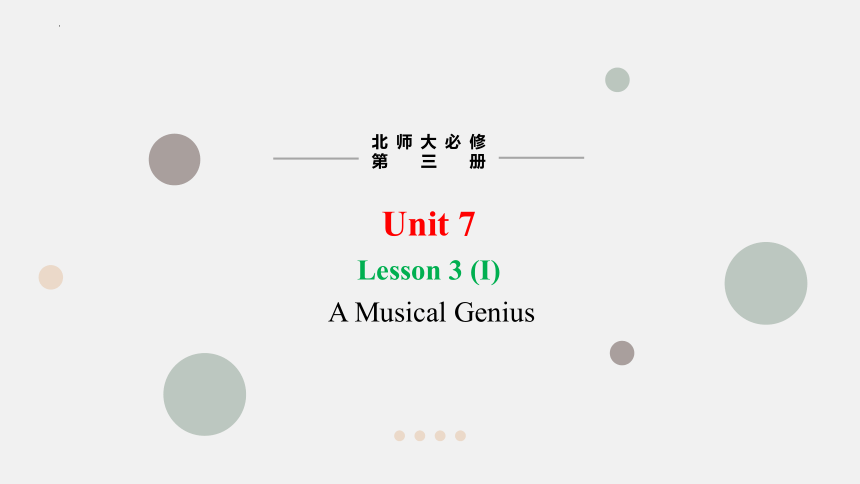 | |
| 格式 | pptx | ||
| 文件大小 | 880.4KB | ||
| 资源类型 | 教案 | ||
| 版本资源 | 北师大版(2019) | ||
| 科目 | 英语 | ||
| 更新时间 | 2024-01-08 15:24:18 | ||
图片预览

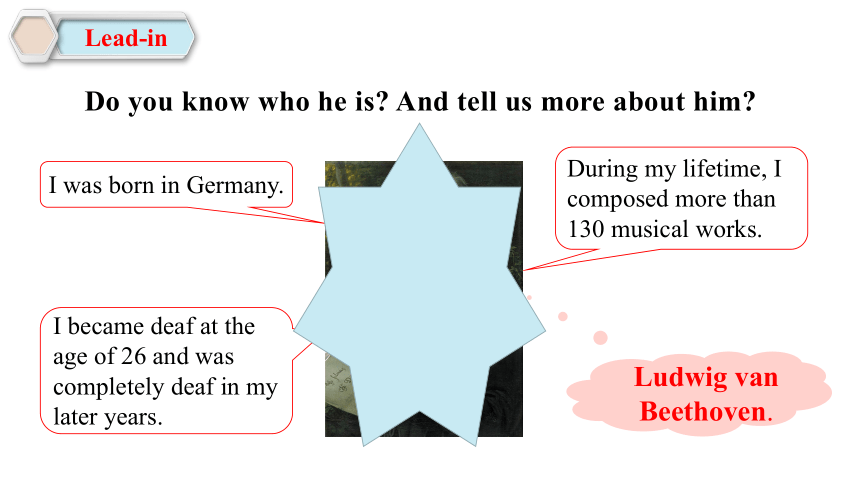
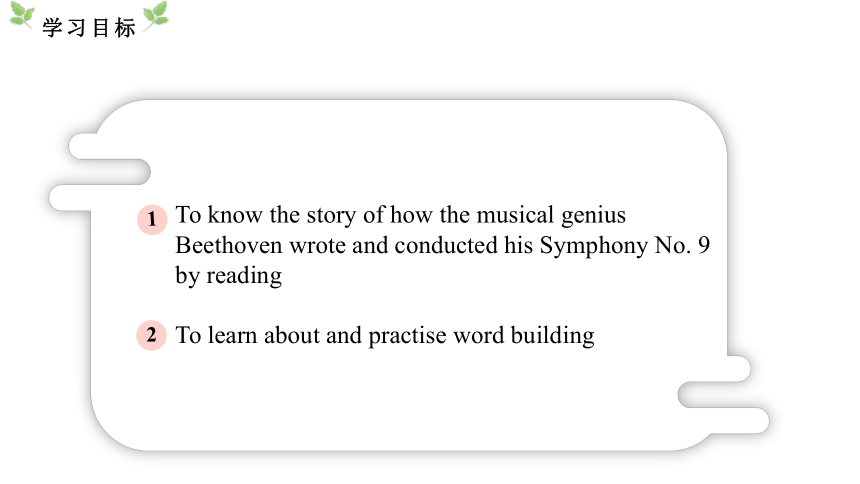
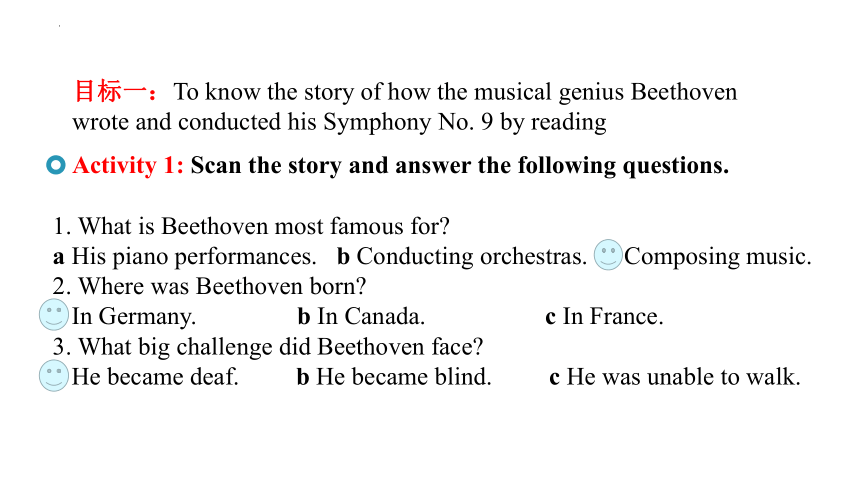
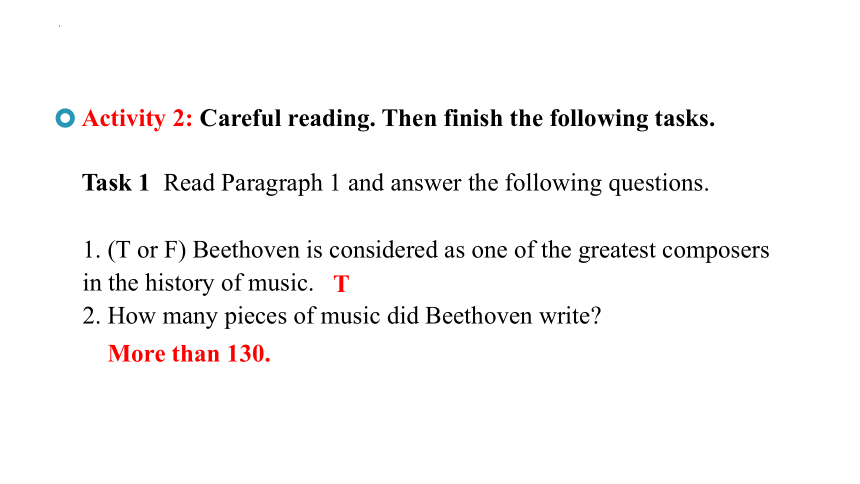
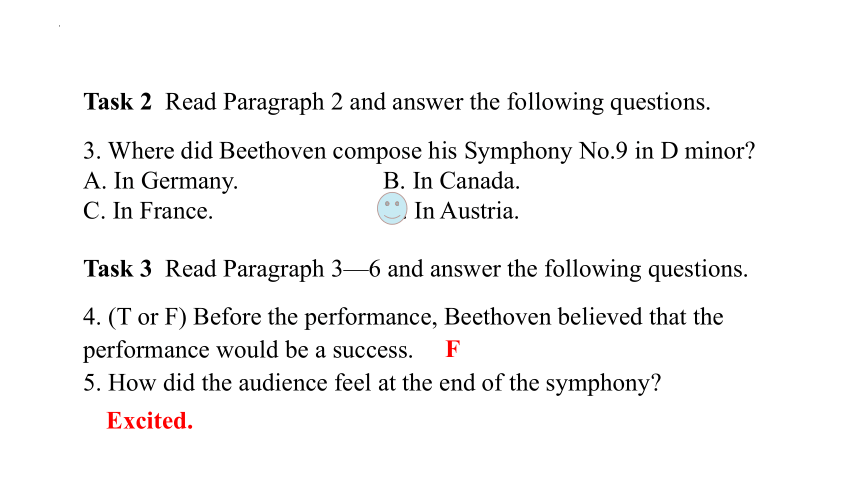

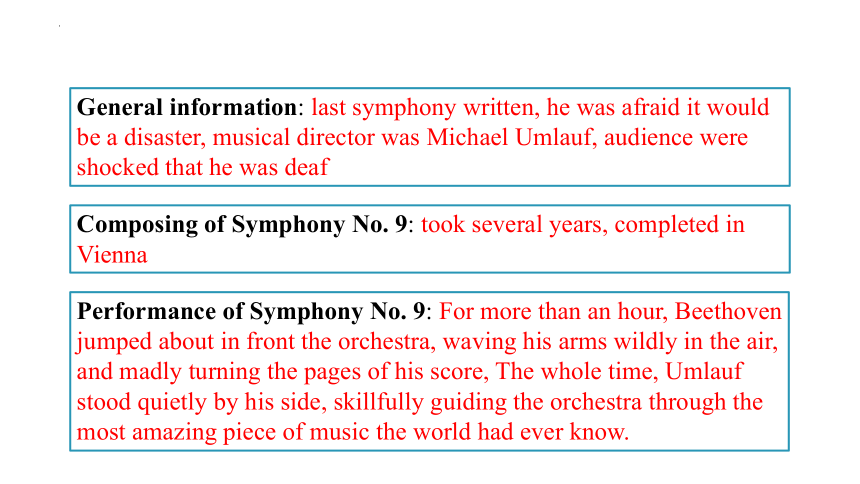
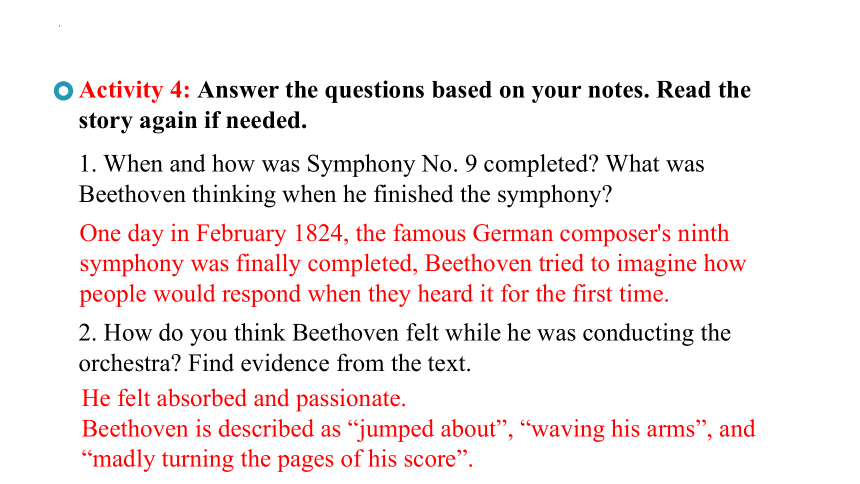

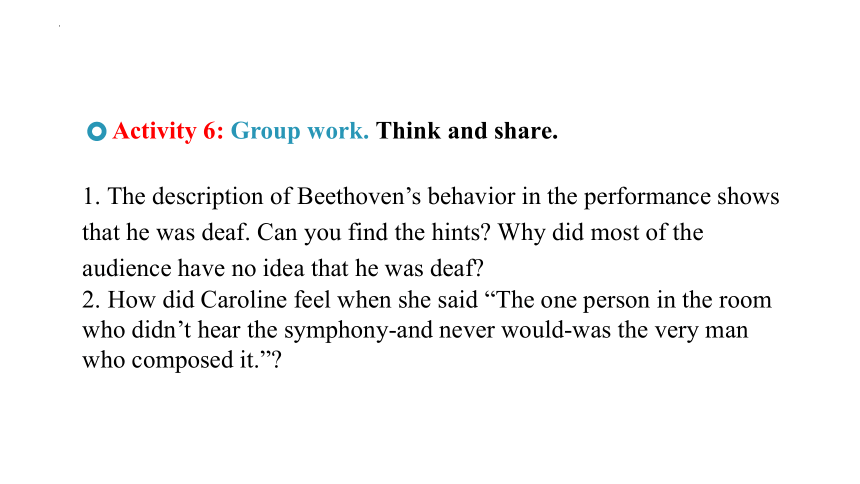
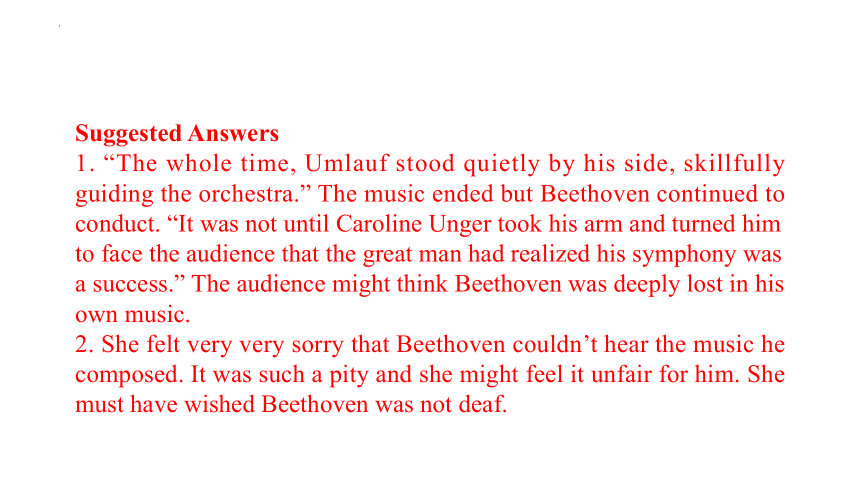
文档简介
(共30张PPT)
北师大必修
第三册
Unit 7
Lesson 3 (I)
A Musical Genius
教学目
Lead-in
Do you know who he is And tell us more about him
During my lifetime, I composed more than 130 musical works.
I became deaf at the age of 26 and was completely deaf in my later years.
I was born in Germany.
Ludwig van Beethoven.
1
2
To know the story of how the musical genius Beethoven wrote and conducted his Symphony No. 9 by reading
To learn about and practise word building
目标一:To know the story of how the musical genius Beethoven wrote and conducted his Symphony No. 9 by reading
Activity 1: Scan the story and answer the following questions.
1. What is Beethoven most famous for
a His piano performances. b Conducting orchestras. c Composing music.
2. Where was Beethoven born
a In Germany. b In Canada. c In France.
3. What big challenge did Beethoven face
a He became deaf. b He became blind. c He was unable to walk.
Activity 2: Careful reading. Then finish the following tasks.
Task 1 Read Paragraph 1 and answer the following questions.
1. (T or F) Beethoven is considered as one of the greatest composers in the history of music.
2. How many pieces of music did Beethoven write
T
More than 130.
Task 2 Read Paragraph 2 and answer the following questions.
3. Where did Beethoven compose his Symphony No.9 in D minor
A. In Germany. B. In Canada.
C. In France. D. In Austria.
Task 3 Read Paragraph 3—6 and answer the following questions.
4. (T or F) Before the performance, Beethoven believed that the performance would be a success.
5. How did the audience feel at the end of the symphony
F
Excited.
Activity 3: Read the story carefully. What can you find about Beethoven's composing of Symphony No. 9 and its first performance Use a graphic organiser to organise the information you find.
Beethoven
General information
Composing of Symphony No.9
Performance of Symphony No.9
Graphic organisers
Graphic organisers are a pictorial way of organising and illustrating information in a text. These include flow charts, tables and diagrams.
Determine the types of the text (e.g. narrative, argumentation, description or exposition).
Analyse the writing technique. Does the text include sequencing, facts and opinion, cause and effect Does it compare and contrast
Determine which type of graphic organiser will illustrate the text in the most effective way.
General information: last symphony written, he was afraid it would be a disaster, musical director was Michael Umlauf, audience were shocked that he was deaf
Composing of Symphony No. 9: took several years, completed in Vienna
Performance of Symphony No. 9: For more than an hour, Beethoven jumped about in front the orchestra, waving his arms wildly in the air, and madly turning the pages of his score, The whole time, Umlauf stood quietly by his side, skillfully guiding the orchestra through the most amazing piece of music the world had ever know.
Activity 4: Answer the questions based on your notes. Read the story again if needed.
1. When and how was Symphony No. 9 completed What was Beethoven thinking when he finished the symphony
2. How do you think Beethoven felt while he was conducting the orchestra Find evidence from the text.
He felt absorbed and passionate.
Beethoven is described as “jumped about”, “waving his arms”, and “madly turning the pages of his score”.
One day in February 1824, the famous German composer's ninth symphony was finally completed, Beethoven tried to imagine how people would respond when they heard it for the first time.
Activity 5: Pair work. Choose one of the following topics to introduce to your partner.
Beethoven as a musician
The performance of Symphony No. 9
Activity 6: Group work. Think and share.
1. The description of Beethoven’s behavior in the performance shows that he was deaf. Can you find the hints Why did most of the audience have no idea that he was deaf
2. How did Caroline feel when she said “The one person in the room who didn’t hear the symphony-and never would-was the very man who composed it.”
Suggested Answers
1. “The whole time, Umlauf stood quietly by his side, skillfully guiding the orchestra.” The music ended but Beethoven continued to conduct. “It was not until Caroline Unger took his arm and turned him to face the audience that the great man had realized his symphony was a success.” The audience might think Beethoven was deeply lost in his own music.
2. She felt very very sorry that Beethoven couldn’t hear the music he composed. It was such a pity and she might feel it unfair for him. She must have wished Beethoven was not deaf.
北师大必修
第三册
Unit 7
Lesson 3 (Ⅱ)
A Musical Genius
目标二:To learn about and practise word building
Activity 1: Identify language points that you want to share with your partner. Discuss in groups and then share with the class.
1. ...but few might know how he created Symphony No. 9 in D minor and how its first show went. ……但是很少有人知道他是怎样创作D小调第九交响曲的,以及这部交响曲首演是怎么进行的。
minor adj. (音乐)小调的,小的,不很重要的
【归纳拓展】
2. Inspired by his struggles with deafness, the composer produced some amazing pieces... 受到与失聪作斗争的启发,这位作曲家创作了一些令人惊叹的作品……
struggle n. 奋斗 vi. 奋斗,拼搏
【归纳拓展】
※ It is a struggle(for sb.)to do sth. (某人)费力做某事
※ struggle with 与……斗争
struggle for 为争取……而斗争
struggle against 与……斗争;为反对……而斗争
struggle to do sth. 努力做某事
struggle to one's feet 挣扎着站起来
3. ...Beethoven tried to imagine how people would respond when they heard it for the first time. ……贝多芬努力想象人们第一次听到这首曲子时会作何反应。
respond vi. & vt. 回应,回复
【归纳拓展】
※ respond to 回应;回答
respond with a smile 报以微笑
respond that 回答
※ 派生:response n. 回答;反应
in response(to) 作为(对……的)回答/反应
make no response(to) 没有(对……)做答/回答
4. The audience did not hesitate to applaud loudly....观众毫不犹豫地大声鼓掌……
hesitate vi. 犹豫,踌躇
【归纳拓展】
※ hesitate to do sth. 犹豫做某事
do not hesitate to do sth. 毫不犹豫做某事
※ 派生:hesitation n. 犹豫
without hesitation 毫不迟疑
5. The theatre’s musical director, Michael Umlauf, joined him and together the two men took charge of the orchestra. 剧院音乐指挥迈克尔·乌姆洛夫也走上台和他一起指挥乐队。
charge n. 主管,负责
【归纳拓展】
※ free of charge/free/for free 免费
in charge of 主管;负责(状态)
in the charge of/in one's charge 由……主管;由……负责
take charge of 负责;主管(动作)
※ vt. 收费,控告,充电
charge sb. money for… 因……向某人收费
charge sb. with sth. 因某事控告某人
charge the battery 给电池充电
Activity 2: Complete the sentences with the phrases below.
took charge of, waving their hats, waving his arms wildly, jumped about, turned him to face, backstage atmosphere,
madly turning the pages, jumped to their feet, with a broad smile
1. Before the performance, the _____________________ was tense.
2. Michael Umlauf joined him and together the two men _____________ the orchestra.
3. Beethoven _____________ in front of the orchestra, ___________________ in the air, and _____________________ of his score.
backstage atmosphere
took charge of
jumped about
waving his arms wildly
madly turning the pages
4. As the final note signalled the end, the audience _________________, clapping, cheering, and _______________.
5. Caroline Unger took Beethoven’s arm and ________________ the
audience.
6. In an interview afterwards, Caroline said _________________, “The audience was shocked as well.
jumped to their feet
waving their hats
turned him to face
with a broad smile
Activity 3: Complete the Word Builder. Use a dictionary to help you.
Noun Verb Adjective
music musician ×
composition ×
performance ×
produce
× conduct ×
hesitate
joy enjoy
respond
musical
composer
compose
performer
perform
production
productive
conductor
hesitation
hesitated
joyous
response
responsive
producer
Look at one of the words ‘produce’ and try to answer some questions.
1. What part of speech is it
2. What is the adjective form How did the word change
3. What are the noun forms How did the word change
Answers
1. It is a verb.
2. productive. It changed by adding the suffix “ive” to the end of the word.
3. producer, production. It changed by adding the suffixes “er” and “ion” to the end of the word.
Now let’s discuss and summarise the use of Word Building.
英语中有Conversion(转化法), Derivation(派生法) , Compounding(合成法) ,Clipping(缩略法),Blending(混合法)
Acronym(首尾字母缩略法) 几种构词法。
其中,派生法(Derivation)就是由词根加上词缀(前缀或后缀)构成的新词。后缀是加在一个单词后面的音节,能够改变单词的词性,有的也可改变词义。
派生法
在词根前面加前缀或者在词根后面加后缀,从而构成一个和原单词意义相近或者相反的新词。
1.前缀
前缀一般改变单词的意义,不改变词性(除少数英语前缀外)
1)表示否定意义的前缀
dis-, il-, in-, ir-, mis-, non-, un-等,在单词前加这类前缀常构成与该词意义相反的新词。
例如:like-dislike; happy-unhappy; existent-nonexistent; understand-misunderstand
构词法(Word Building)
2) 表示其他意义的前缀:
a- (多构成表语形容词), anti-(反对), auto-(自动), co-(共同), en-(使), inter-(互相), re-(又;再), sub-(下面的;次;小), tele-(强调距离)等。
例如:like-alike; war-antiwar; matic-automatic; worker-coworker; large-enlarge; national-international; union-reunion; way-subway; phone-telephone
2.后缀
后缀一般改变单词的词性,少数后缀会改变单词的词义。
1)构成名词的后缀
-tion(动作;过程), -ness(性质;状态), -ment(性质;状态), -ian(精通……的人), -ist(专业人员), -er/or(从事某事的人)
例如:produce-production; deaf-deafness; move-movement; music-musician; femine-feminist; lead-leader/direct-director
2)构成动词的后缀
-en(多用于形容词之后), -fy(使……化), -ize(使……成为)
例如:sharp-sharpen; beauty-beautify; real-realize
3)构成形容词的后缀
-al/able (有……能力的), -ive(性质;倾向), -ous(具有……), -ful(充满……), -less(表示否定)
例如:music-musical; act-active; joy-joyous; use-useful; home-homeless
Activity 4: Complete the sentences with the correct form of the words in the Word Builder.
1. It has always been my dream to ________ an orchestra.
2. The musician __________ with nervousness before he began to play.
3. Beethoven is recognised as a _______ genius by people around the world.
4. Beethoven is the _________ of Symphony No. 9 in D minor.
5. To his mother’s ____, he won first prize.
6. She told me about the wonderful ___________ that she had been to last week.
7. The audience’s _________ to the performance of the symphony was extraordinary.
8. Though Beethoven lost his hearing, he _________ some amazing pieces of music.
conduct
hesitated
musical
composer
joy
performance
response
produced
1. Let’s retell the story of Beethoven together!
2. Name some more derivatives.
北师大必修
第三册
Unit 7
Lesson 3 (I)
A Musical Genius
教学目
Lead-in
Do you know who he is And tell us more about him
During my lifetime, I composed more than 130 musical works.
I became deaf at the age of 26 and was completely deaf in my later years.
I was born in Germany.
Ludwig van Beethoven.
1
2
To know the story of how the musical genius Beethoven wrote and conducted his Symphony No. 9 by reading
To learn about and practise word building
目标一:To know the story of how the musical genius Beethoven wrote and conducted his Symphony No. 9 by reading
Activity 1: Scan the story and answer the following questions.
1. What is Beethoven most famous for
a His piano performances. b Conducting orchestras. c Composing music.
2. Where was Beethoven born
a In Germany. b In Canada. c In France.
3. What big challenge did Beethoven face
a He became deaf. b He became blind. c He was unable to walk.
Activity 2: Careful reading. Then finish the following tasks.
Task 1 Read Paragraph 1 and answer the following questions.
1. (T or F) Beethoven is considered as one of the greatest composers in the history of music.
2. How many pieces of music did Beethoven write
T
More than 130.
Task 2 Read Paragraph 2 and answer the following questions.
3. Where did Beethoven compose his Symphony No.9 in D minor
A. In Germany. B. In Canada.
C. In France. D. In Austria.
Task 3 Read Paragraph 3—6 and answer the following questions.
4. (T or F) Before the performance, Beethoven believed that the performance would be a success.
5. How did the audience feel at the end of the symphony
F
Excited.
Activity 3: Read the story carefully. What can you find about Beethoven's composing of Symphony No. 9 and its first performance Use a graphic organiser to organise the information you find.
Beethoven
General information
Composing of Symphony No.9
Performance of Symphony No.9
Graphic organisers
Graphic organisers are a pictorial way of organising and illustrating information in a text. These include flow charts, tables and diagrams.
Determine the types of the text (e.g. narrative, argumentation, description or exposition).
Analyse the writing technique. Does the text include sequencing, facts and opinion, cause and effect Does it compare and contrast
Determine which type of graphic organiser will illustrate the text in the most effective way.
General information: last symphony written, he was afraid it would be a disaster, musical director was Michael Umlauf, audience were shocked that he was deaf
Composing of Symphony No. 9: took several years, completed in Vienna
Performance of Symphony No. 9: For more than an hour, Beethoven jumped about in front the orchestra, waving his arms wildly in the air, and madly turning the pages of his score, The whole time, Umlauf stood quietly by his side, skillfully guiding the orchestra through the most amazing piece of music the world had ever know.
Activity 4: Answer the questions based on your notes. Read the story again if needed.
1. When and how was Symphony No. 9 completed What was Beethoven thinking when he finished the symphony
2. How do you think Beethoven felt while he was conducting the orchestra Find evidence from the text.
He felt absorbed and passionate.
Beethoven is described as “jumped about”, “waving his arms”, and “madly turning the pages of his score”.
One day in February 1824, the famous German composer's ninth symphony was finally completed, Beethoven tried to imagine how people would respond when they heard it for the first time.
Activity 5: Pair work. Choose one of the following topics to introduce to your partner.
Beethoven as a musician
The performance of Symphony No. 9
Activity 6: Group work. Think and share.
1. The description of Beethoven’s behavior in the performance shows that he was deaf. Can you find the hints Why did most of the audience have no idea that he was deaf
2. How did Caroline feel when she said “The one person in the room who didn’t hear the symphony-and never would-was the very man who composed it.”
Suggested Answers
1. “The whole time, Umlauf stood quietly by his side, skillfully guiding the orchestra.” The music ended but Beethoven continued to conduct. “It was not until Caroline Unger took his arm and turned him to face the audience that the great man had realized his symphony was a success.” The audience might think Beethoven was deeply lost in his own music.
2. She felt very very sorry that Beethoven couldn’t hear the music he composed. It was such a pity and she might feel it unfair for him. She must have wished Beethoven was not deaf.
北师大必修
第三册
Unit 7
Lesson 3 (Ⅱ)
A Musical Genius
目标二:To learn about and practise word building
Activity 1: Identify language points that you want to share with your partner. Discuss in groups and then share with the class.
1. ...but few might know how he created Symphony No. 9 in D minor and how its first show went. ……但是很少有人知道他是怎样创作D小调第九交响曲的,以及这部交响曲首演是怎么进行的。
minor adj. (音乐)小调的,小的,不很重要的
【归纳拓展】
2. Inspired by his struggles with deafness, the composer produced some amazing pieces... 受到与失聪作斗争的启发,这位作曲家创作了一些令人惊叹的作品……
struggle n. 奋斗 vi. 奋斗,拼搏
【归纳拓展】
※ It is a struggle(for sb.)to do sth. (某人)费力做某事
※ struggle with 与……斗争
struggle for 为争取……而斗争
struggle against 与……斗争;为反对……而斗争
struggle to do sth. 努力做某事
struggle to one's feet 挣扎着站起来
3. ...Beethoven tried to imagine how people would respond when they heard it for the first time. ……贝多芬努力想象人们第一次听到这首曲子时会作何反应。
respond vi. & vt. 回应,回复
【归纳拓展】
※ respond to 回应;回答
respond with a smile 报以微笑
respond that 回答
※ 派生:response n. 回答;反应
in response(to) 作为(对……的)回答/反应
make no response(to) 没有(对……)做答/回答
4. The audience did not hesitate to applaud loudly....观众毫不犹豫地大声鼓掌……
hesitate vi. 犹豫,踌躇
【归纳拓展】
※ hesitate to do sth. 犹豫做某事
do not hesitate to do sth. 毫不犹豫做某事
※ 派生:hesitation n. 犹豫
without hesitation 毫不迟疑
5. The theatre’s musical director, Michael Umlauf, joined him and together the two men took charge of the orchestra. 剧院音乐指挥迈克尔·乌姆洛夫也走上台和他一起指挥乐队。
charge n. 主管,负责
【归纳拓展】
※ free of charge/free/for free 免费
in charge of 主管;负责(状态)
in the charge of/in one's charge 由……主管;由……负责
take charge of 负责;主管(动作)
※ vt. 收费,控告,充电
charge sb. money for… 因……向某人收费
charge sb. with sth. 因某事控告某人
charge the battery 给电池充电
Activity 2: Complete the sentences with the phrases below.
took charge of, waving their hats, waving his arms wildly, jumped about, turned him to face, backstage atmosphere,
madly turning the pages, jumped to their feet, with a broad smile
1. Before the performance, the _____________________ was tense.
2. Michael Umlauf joined him and together the two men _____________ the orchestra.
3. Beethoven _____________ in front of the orchestra, ___________________ in the air, and _____________________ of his score.
backstage atmosphere
took charge of
jumped about
waving his arms wildly
madly turning the pages
4. As the final note signalled the end, the audience _________________, clapping, cheering, and _______________.
5. Caroline Unger took Beethoven’s arm and ________________ the
audience.
6. In an interview afterwards, Caroline said _________________, “The audience was shocked as well.
jumped to their feet
waving their hats
turned him to face
with a broad smile
Activity 3: Complete the Word Builder. Use a dictionary to help you.
Noun Verb Adjective
music musician ×
composition ×
performance ×
produce
× conduct ×
hesitate
joy enjoy
respond
musical
composer
compose
performer
perform
production
productive
conductor
hesitation
hesitated
joyous
response
responsive
producer
Look at one of the words ‘produce’ and try to answer some questions.
1. What part of speech is it
2. What is the adjective form How did the word change
3. What are the noun forms How did the word change
Answers
1. It is a verb.
2. productive. It changed by adding the suffix “ive” to the end of the word.
3. producer, production. It changed by adding the suffixes “er” and “ion” to the end of the word.
Now let’s discuss and summarise the use of Word Building.
英语中有Conversion(转化法), Derivation(派生法) , Compounding(合成法) ,Clipping(缩略法),Blending(混合法)
Acronym(首尾字母缩略法) 几种构词法。
其中,派生法(Derivation)就是由词根加上词缀(前缀或后缀)构成的新词。后缀是加在一个单词后面的音节,能够改变单词的词性,有的也可改变词义。
派生法
在词根前面加前缀或者在词根后面加后缀,从而构成一个和原单词意义相近或者相反的新词。
1.前缀
前缀一般改变单词的意义,不改变词性(除少数英语前缀外)
1)表示否定意义的前缀
dis-, il-, in-, ir-, mis-, non-, un-等,在单词前加这类前缀常构成与该词意义相反的新词。
例如:like-dislike; happy-unhappy; existent-nonexistent; understand-misunderstand
构词法(Word Building)
2) 表示其他意义的前缀:
a- (多构成表语形容词), anti-(反对), auto-(自动), co-(共同), en-(使), inter-(互相), re-(又;再), sub-(下面的;次;小), tele-(强调距离)等。
例如:like-alike; war-antiwar; matic-automatic; worker-coworker; large-enlarge; national-international; union-reunion; way-subway; phone-telephone
2.后缀
后缀一般改变单词的词性,少数后缀会改变单词的词义。
1)构成名词的后缀
-tion(动作;过程), -ness(性质;状态), -ment(性质;状态), -ian(精通……的人), -ist(专业人员), -er/or(从事某事的人)
例如:produce-production; deaf-deafness; move-movement; music-musician; femine-feminist; lead-leader/direct-director
2)构成动词的后缀
-en(多用于形容词之后), -fy(使……化), -ize(使……成为)
例如:sharp-sharpen; beauty-beautify; real-realize
3)构成形容词的后缀
-al/able (有……能力的), -ive(性质;倾向), -ous(具有……), -ful(充满……), -less(表示否定)
例如:music-musical; act-active; joy-joyous; use-useful; home-homeless
Activity 4: Complete the sentences with the correct form of the words in the Word Builder.
1. It has always been my dream to ________ an orchestra.
2. The musician __________ with nervousness before he began to play.
3. Beethoven is recognised as a _______ genius by people around the world.
4. Beethoven is the _________ of Symphony No. 9 in D minor.
5. To his mother’s ____, he won first prize.
6. She told me about the wonderful ___________ that she had been to last week.
7. The audience’s _________ to the performance of the symphony was extraordinary.
8. Though Beethoven lost his hearing, he _________ some amazing pieces of music.
conduct
hesitated
musical
composer
joy
performance
response
produced
1. Let’s retell the story of Beethoven together!
2. Name some more derivatives.
同课章节目录
- Unit 7 Art
- Lesson 1 Masterpieces
- Lesson 2 Beijing Opera
- Lesson 3 A Musical Genius
- Unit 8 Green living
- Lesson 1 Roots and Shoots
- Lesson 2 Greening the Desert
- Lesson 3 "White Bikes" on the Road
- Unit 9 Learning
- Lesson 1 Active Learning
- Lesson 2 Language Learning Tips
- Lesson 3 The Secrets of Your Memory
